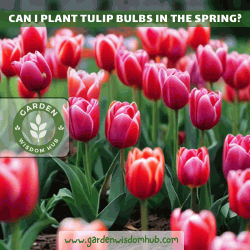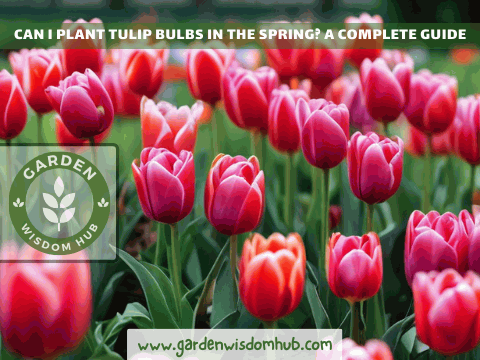Planting tulips in spring:
Spring time is the perfect time to get your hands dirty and bring some amazing shine to your garden with tulip bulbs. Trust me, you won’t be disappointed by the explosion of vibrant colors! Who says you have to stick to tradition and usual gardening norms?
What happens if you plant tulip bulbs in the spring?
If you missed the fall planting window or just prefer spring gardening, fear not! Spring planting is a viable option for you.
Get ready to become a tulip planting pro with this guide! We’ve got all the expert advice and practical tips you need to make your spring bulb planting a blooming success.
How to plant tulips in the spring?
Planting tulip bulbs at just the right time is key to achieving a jaw-dropping bloom. As any seasoned gardener knows, autumn is the prime time to plant tulip bulbs. These little guys need their beauty sleep before they can burst forth with vibrant blooms in the spring. Root development relies on this much-needed dormancy period.
Can you plant tulips in the winter or autumn?
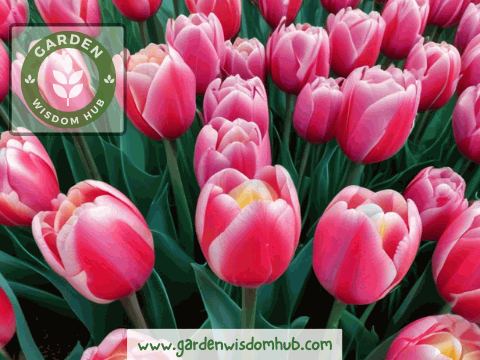
As autumn arrives, the soil temperatures take a dip, giving the bulbs a nudge to begin their root-growing endeavors.
Ah, the wonders of this cool weather! It’s like a boot camp for plants, helping them build those strong root systems and master the art of nutrient and water absorption. All in preparation for their grand performance of growth and flowering. Quite the important period, I must say!
What happens if you plant tulip bulbs in the spring?
Who knew spring tulip bulb planting could be so fun? It’s worth it when those magnificent blooms appear! Spring-planted bulbs should be solid and mold-free. Once you have them, plant them immediately. Remember, time is everything plant them early so they can settle in and grow roots before blooming.
When to plant tulip bulbs in pots?
When to plant spring tulip bulbs might be tricky. It depends on your climate and soil. So unleash your gardening detective side! For best results, make sure the ground isn’t frozen or swampy. Aim for soil temperatures about 55°F (13°C) or cooler.
- Watch this YouTube Video For More Guide Related to Top Tips to Plant Tulips Bulbs
Can you plant tulips in the spring?

If you are wondering that Can I Plant Tulip Bulbs in the Spring? Yes, you can. Please check the soil quality to ensure it’s not sticky and fertile enough to make plants go ‘Oh la la!’ Increase soil fertility using compost or well-rotted manure. If the pH is off, correct it a little. For healthy plants, locate a sunny area. If you have limited garden area or poor soil, try planting in containers or raised beds.
The innovative and funny solution maximizes gardening efforts. Join us in the wonderful world of planting! We’ll discuss how to become a green-thumbed genius. Prepare to unleash your horticultural genius! Let’s discuss bulb planting for the best outcomes.
How deep to plant tulip bulbs in spring?
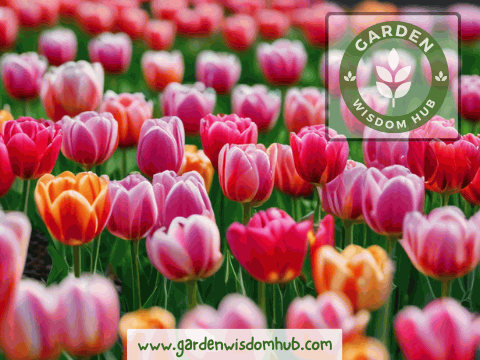
First, buy high-quality bulbs. When planting, bury them 6-8 inches deep with the sharp end up. Put those lights 4-6 inches apart for breathing room. Happy planting! Don’t overwater bulbs after planting. Why not use mulch to keep the soil happy?
How Long Do Tulips Bloom?
Make sure your tulips get enough sunlight and water regularly. Be careful not to drown them! Put some balanced, slow-release fertilizer on them and mulch to keep them warm and hydrated. Watch out for pests and illnesses, and remove spent blooms after their time has come.
How to plant tulips in spring?
Absolutely! Let me elaborate on each way to plant tulips in spring.
Planting tulips in the spring:
Importance of Soil Temperature: Fancy tulip bulbs flourish at 55°F (13°C) or cooler. Root development matters, right? Planting in heated soil might cause confused roots, similar to a lost tourist in a new country.
Can tulip bulbs be planted in spring and Climate Variability Impact:
Who knew spring temperatures might affect tulip planting? Like Mother Nature’s way of keeping us guessing! Gardeners should always monitor weather and soil changes. Does your climate and soil support gardening? Know your climate to know when to sow tulip bulbs in spring. The ground shouldn’t be freezing or damp.
Can I plant tulip bulbs in pots in the spring?
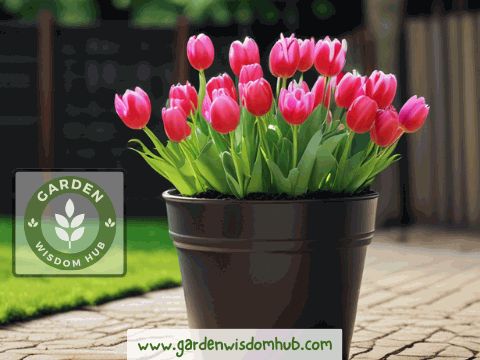
Yes, you can. For healthy growth of the plant, follow the below mentioned tips. Get ready for spring gardening!
Investigating Soil Quality:
Do you wish to provide your tulips with the best environment? Lucky you! Well-draining, organically rich soil is ideal for tulips. Like finding gardening’s holy grail! Your tulips will be the envy of the neighborhood with this amazing soil. Tulips need good drainage to thrive. Waterlogged environments bother them!
Enhancing Soil Using Compost:
For your tulip bulbs to thrive like they’re on a tropical vacation, you should add compost or well-rotted manure to your soil. Give your plants a VIP fertilizer party pass!
A Tulip’s Secret Obsession:
Soil pH Tulips have a soil pH diva complex. They are slightly acidic to neutral (6.0–7.0). They have a soil preference and won’t settle for less! A soil test may suggest adding lime or sulfur to change the pH of your soil. Like pampering your soil!
Can you plant bloomed tulips in the spring and Best Planting Times:
Tulip bulbs are best planted in late March to early April in most areas. Give bulbs time to root before the summer heat. Weather can be unpredictable, throwing us off. Do not worry! We can always adjust to odd weather.
Imagine you’re ready to plant your crops, but Mother Nature throws you a surprise with amazing weather. Your typical planting time disappears! Climate fluctuation can ruin your plans, like when spring is too hot or chilly. Like nature’s way of keeping us guessing! Gardeners should always monitor local weather and soil conditions. You never know when Mother Nature will surprise you!
Specific Climate Zone Timing:
Climate zone affects planting time. Hide and seek with Mother Nature! In warmer climates, planting can begin in late February. More patience is needed in cooler climates until the fear of a strong frost has gone, usually around mid-April.
Planting:
When choosing bulbs, choose the best. Find bulbs as firm as a bodybuilder’s bicep and immaculate as a supermodel’s. Avoid bulbs with mildew or soft spots—nobody likes acne-ridden bulbs! It’s commonly known that larger bulbs produce better blooms.
Tulip bulb planting depth and spacing.
You want to dig a 6-8-inch hole. Make sure the bulb’s pointed end is up to avoid confused tulips! Plant them 4-6 inches apart for breathing room. That way, they won’t step on each other. Happy planting! For ease, maintain rows 12 inches apart. I promise it will simplify maintenance.
Make these bulbs cozy in their dirt beds. Water them well to settle the soil and grow roots. It’s like putting them to bed! Do not drown your plants—bulb rot may result!
Spring-Planted Tulip Care:
Let’s discuss sunshine requirements. Sun-loving tulips need 6-8 hours of direct sunshine daily. Like tiny solar-powered flowers! A place with less sunlight may result in poor blooming or weaker stems.
A Plant Watering Guide:
Soak water tulips immediately after planting. It’s like a pep talk to strengthen those roots! Keep your plants hydrated, especially in dry weather. Don’t overwater them!
Plant nutrition for maximum growth:
Fertilize your bulbs at the right time for best results. Apply it when you plant them and again when shoots appear. This will help your bulbs grow big and strong. Avoid high-nitrogen fertilizers, friend.
The Mulching Art:
Moisture and Temperature Control Mastery Did you know mulch is a garden superhero? It saves the day by moistening the soil, suppressing weeds, and controlling soil temperatures. It’s like having a smart and clever gardening partner! Spread mulch abundantly around your plants, taking care not to suffocate young growth.
Shielding Tulips from Cold Snaps:
Covering with garden fleece is fascinating:
Give your tulips a garden fleece or other covering for late frosts. Guess what—mulching can help regulate soil temperature. It’s like wrapping your soil in a warm or cool blanket for the season. Pretty cool, huh?
Recovery/Hibernation:
Removing spent tulip blooms is wise. We can use the plant’s energy for something more significant than generating seeds. Goodbye, old flowers! Why rush cleanup? Enjoy the yellow foliage’s elegant departure as nature takes its course.
Embracing foliage withering and dying provides benefits. Leave the foliage so plants can photosynthesize and store energy in the bulb for a great comeback next year.
Store Tulip Bulbs for Replanting:
After their spectacular display, tulips need some TLC. Clean those bulbs first. Find a cold, dry place to keep them until autumn, when you can plant them again. This is like giving your tulips a break before their big show!
Final thoughts on spring tulip planting benefits:

I have a clever and amusing story. A smart mind who could make people laugh once existed. They could light any room with their incomparable wit and brilliance. Spring planting may convert your yard into a bright masterpiece. Gardening is fun for all ability levels.
Can tulip bulbs be planted in the spring successfully?
With a little knowledge and a green thumb, you can plant tulip bulbs in April and see your landscape explode with color. Prepping the soil, planting them correctly, and caring for them are key.
Conclusion: Can I plant tulip bulbs in pots in the spring?
In a nutshell, planting tulip bulbs in spring is a unique and enjoyable gardening option. By scheduling and caring for your tulip bulbs, you’ll have a stunning display of vivid blossoms in your yard in spring. Spring gardening is magical, and tulip bulbs will convert your garden into a masterpiece.
To learn more about Flower Garden check out my guides:
15 Plants with Black and White Flowers
Easiest Way to Grow Calendula from Seed
James Porter
Welcome to our haven of gardening and plant care, where outdoor and indoor planting enthusiasts come together! At Gardening Wisdom Hub, we aim to provide you with the most authentic information on anything related to gardening, plant care, seasonal planting etc.
The author of our website is James Porter, an experienced industry veteran. He has a deep interest in everything green. James’s enthusiasm for exploring plants’ features and learning new gardening methods began at a young age. Gradually, his passion increased with time, leading him to become a highly esteemed professional. His extensive knowledge makes him a priceless resource for inexperienced and seasoned gardeners.

